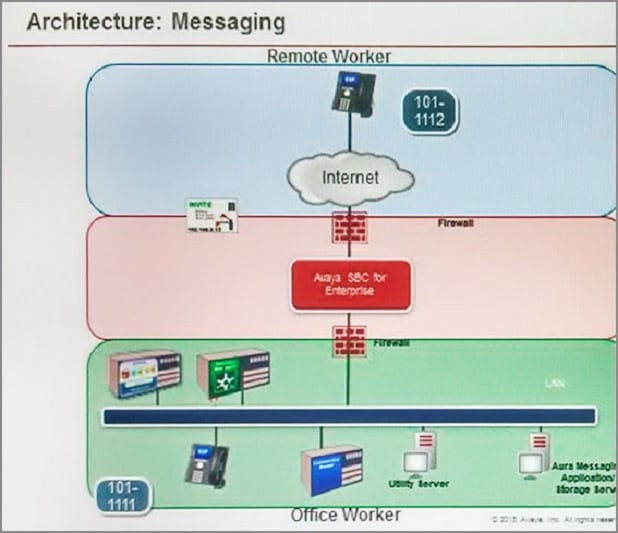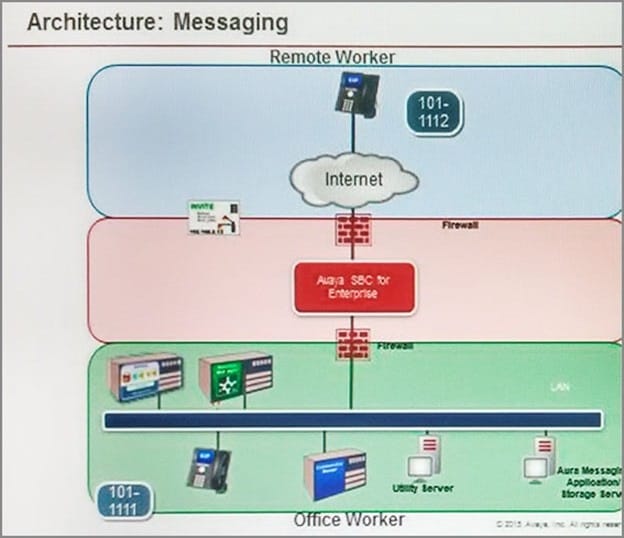Exam Details
Exam Code
:7230XExam Name
:Avaya Aura Communication Applications SupportCertification
:Avaya CertificationsVendor
:AvayaTotal Questions
:93 Q&AsLast Updated
:Mar 23, 2025
Avaya Avaya Certifications 7230X Questions & Answers
-
Question 71:
When a customer calls voicemail to retrieve their messages they hear "Hello, to access your mailbox..." instead of the users named followed by "please enter your password...".
After troubleshooting you discover that the Caller ID is not being sent correctly, therefore Avaya Aura® Messaging (AAM) is not able to identify the correct mailbox associated with the station number calling into AAM.
How can this problem be fixed?
A. Change clid-numbering 0 SAT form to send the correct CLID.
B. Using AAM web GUI access Administration > Messaging > Telephone Integration, write a caller ID modification rule to correct the incoming CLID format.
C. In Session Manager, configure a DigitConversionAdapter with `fromto=true' to update the `Form' header as well as the P-asserted-identity, and link it to the AAM SIP Entity.
D. Having identified the trunk group from Avaya Aura? Communication Manager (CM) to AMM is public, change public-unknown-numbering 0 SAT form, to send the correct CLID.
-
Question 72:

Refer to the exhibit.
After some system maintenance was completed over the weekend, a customer calling from the office states they hear a fast busy when trying to access their voicemail. Avaya support verifies local network connectivity is up and Avaya Aura® Messaging server is registering
no alarms. A SIP trace displays a 404 Not Found error message.
Based on what is already working, to where can the issue potentially be isolated?
A. endpoint routing configuration issue
B. interoperability testing
C. network outage
D. routing configuration issues
-
Question 73:
You are troubleshooting a TLS link down message between Avaya Aura® Session Manager (SM) and
Avaya Session Border Controller for Enterprise (SBCE). Tracing on SM and SBCE reveals a Fatal Error
Unknown CA message being sent by SBCE when it receives the Server Identity certificate from SM.
To solve this problem, which two actions need to be completed? (Choose two.)
A. Install the Certificate Authority certificate that signed SBCE identity certificate into SM.
B. Export the SBCE identity certificate, and import it into SM.
C. Install the Certificate Authority certificate that signed SM identity certificate into SBCE.
D. Add Certificate Authority certificate into the TLS profile Peer Verification List.
-
Question 74:
Incoming SIP Trunking calls from Service Provider to Session Manager are failing because Avaya Session Border Controller for Enterprise (SBCE) is not sending a domain name in the TO, FROM and REQUEST headers.
What needs to be changed in SBCE to make this happen?
A. In SBCE GUI, navigate to Global Profiles > Routing. Edit the Session Manager Routing Profile to link to a URI Group, which has the To, From and Request Headers and Replace Action set to Overwrite with domain name.
B. In SBCE GUI, navigate to Global Profiles > Server Configuration. Edit the Session Manager server entry to set "Overwrite Domain Name".
C. In SBCE GUI, navigate to Global Profiles > Topology Hiding. Edit the SessionManager_TH to change the To, From and Request Headers Replace Action, to Overwrite with domain name.
D. In SBCE GUI, navigate to Device Specific Settings > Endpoint Flows > Server Flows. Edit the Session Manager flow to change the End Point Policy Group to default-low.
-
Question 75:

Refer to the exhibit.
Avaya Tier 3 support receives a case escalated by Tier 2 where the customer cannot receive incoming calls, but can make calls out successfully. The trace shows that the incoming calls arrive at the Avaya Session Border Controller for Enterprise (SBCE) but fail to get routed into the customer enterprise network.
Based on this information, what is and is not working?
A. The local area network, Avaya Aura® Communication Manager, and Avaya Aura® Session Manager are working. SBCE is partially working, but routing may be incorrect.
B. The local area network, Avaya Aura® Communication Manager, and Avaya Aura® Session Manager are working. The public network is not working.
C. The local area network, Avaya Aura® Communication Manager, and Avaya Aura® Session Manager are working. SBCE is not working.
D. The local area network and Avaya Aura® Session Manager are working. Avaya Aura® Communication
Manager is not working.
-
Question 76:
Which statement about Network Routing Policies in Avaya Aura® Session Manager (SM) is true?
A. A dial pattern and routing policy are necessary in SM to call from an H323 device to a Basic/Native SIP device (without an Avaya Aura® Communication Manager profile).
B. A dial pattern and routing policy are necessary in SM to call from a Basic/Native SIP device (without a CM profile) to an H323 device on Avaya Aura® Communication Manager (CM).
C. A dial pattern and routing policy are necessary in SM to call from an H323 device to an AST device on the same Avaya Aura® Communication Manager (CM).
D. A dial pattern and routing policy are necessary in SM to call from an AST device to an H323 device on the same Avaya Aura® Communication Manager (CM).
-
Question 77:
You are troubleshooting an IM and Presence problem, and discover all application processes are not running on the Avaya Breeze TM platform.
How can the application processes be started?
A. SSH to Avaya Breeze ™, and execute the start –a command.
B. SSH to Avaya Breeze ™, and execute the service presence start command.
C. Accept Service on the cluster using Avaya Aura? System Manager web GUI.
D. SSH to Avaya Breeze ™, and execute the service ps start command.
-
Question 78:
A customer called in stating they cannot place WebRTC calls. You discover that when the WebRTC snap-in sends an Invite to Avaya Aura® Media Server (AAMS), Avaya Breeze ™ is not sending the correct information in the Request URI to match a regular expression in Session Manager. Where do you configure the Media Server URI ([email protected]) that Avaya Breeze ™ will send to AAMS via Avaya Aura® Session Manager (SM)?
A. Use Avaya Aura® System Manager web GUI to access the Engagement Development Platform > Configuration > Attributes.
B. Use SSH to Avaya Breeze ™ and edit the “/etc/config.properties” file.
C. Use Avaya Aura® System Manager web GUI to access the Inventory > Manage Elements, and then edit the Avaya Breeze ™ element.
D. Use Avaya Aura® System Manager web GUI to access the Engagement Development Platform > Configuration > Avaya Aura® Media Server.
-
Question 79:
A customer reports that their Avaya Aura® Communication Manager (CM) enabled SIP telephones (AST) can only see the effect of their telephone being Call Forwarded after they log off and log on again. Also stopping the call forward feature does not show until their endpoint is logged off and logged on again.
What is the cause of the problem?
A. A coverage path has not been setup.
B. The Call Forwarding feature has not been assigned to a button.
C. Data Privacy is enabled in the station's Class of Service.
D. An entry is missing in the private-numbering System Administration Terminal (SAT) form.
-
Question 80:
Callers hear a fast busy when they dial into Avaya Aura® Messaging (AAM) to retrieve their voicemail messages. After troubleshooting you discover that someone has left trunks in busy-out state on AAM.
How would you restore the trunks to in-service status?
A. Using AAM web GUI access Administration > Messaging > Diagnostics > Network Connection, and then click on the Release All Trunks button.
B. SSH to AAM, and execute the release trunks all command.
C. SSH to AAM, and execute the release trunk command.
D. Using AAM web GUI access Administration > Messaging > Telephony Diagnostics > Release, type `all' in the Equipment Number field, and then click on the Release button.
Related Exams:
3104
Avaya one-X UC Soft Clients Implementation and Maintenance3107
Avaya Session Border Controller Enterprise Implementation and Maintenance31860X
Avaya IX Calling Design3300
Avaya Aura Contact Center Administration3301
Avaya Aura Contact Centre Maintenance & Troubleshooting3304
Avaya Call Center Elite Implementation and Maintenance3312
Avaya Aura Contact Center Administration3313
Avaya Aura Contact Center Maintenance and Troubleshooting33160X
Avaya Workforce Engagement Support Certified33810X
Avaya Aura Contact Center Solution Design
Tips on How to Prepare for the Exams
Nowadays, the certification exams become more and more important and required by more and more enterprises when applying for a job. But how to prepare for the exam effectively? How to prepare for the exam in a short time with less efforts? How to get a ideal result and how to find the most reliable resources? Here on Vcedump.com, you will find all the answers. Vcedump.com provide not only Avaya exam questions, answers and explanations but also complete assistance on your exam preparation and certification application. If you are confused on your 7230X exam preparations and Avaya certification application, do not hesitate to visit our Vcedump.com to find your solutions here.